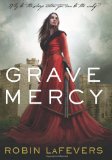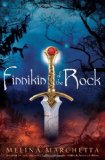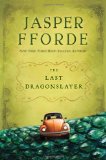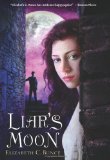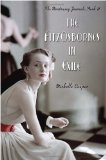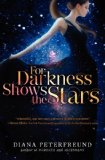Review of Grave Mercy, by Robin LaFevers
His Fair Assassin, Book I
by Robin LaFevers
Houghton Mifflin Books for Children, 2012. 509 pages.
Starred Review
Wow. This book reminded me of The Canterbury Papers, full of medieval palace intrigue, but this had supernatural powers thrown in.
The book is set in Brittany, beginning in 1485. Ismae has been told from birth that the scar she was born with, from the midwife’s poison failing, marks her as the daughter of Death himself, an ancient Breton god now called St. Mortain. When the man her father sold her to sees the scar, he is going to have her burned, but she is rescued by strangers and sent to the convent of St. Mortain.
At the convent, Ismae learns the special powers she has as the daughter of St. Mortain. She can see a mark on a person who is going to die. Poison does not harm her. She can see a person’s soul when it leaves his body. Also at the convent, they train her to be an assassin.
“If you choose to stay, you will be trained in His arts. You will learn more ways to kill a man than you imagined possible. We will train you in stealth and cunning and all manner of skills that will ensure no man is ever again a threat to you.”
Three years later, Ismae is ready for her first assignments. But now there is political trouble, and Brittany is in danger of being swallowed up by France. Ismae is sent to the court of the duchess herself, ordered to pose as the mistress of Duval, the duchess’s half-brother.
But at court, things don’t turn out as Ismae has been led to believe they will. Those she was told to be suspicious of seem kind and seem to have the Duchess’s best interests at heart. Those she is supposed to trust seem suspicious. What is right?
Meanwhile, there’s plenty of action and adventure. There are surprise attacks and deaths that Ismae had nothing to do with. And the duchess must marry soon, preferably to someone who can bring an army to her cause. Along the way, slowly and exquisitely, we see Ismae’s heart being won by a good man.
Here’s the situation as it’s laid out before Ismae leaves the convent:
Crunard spreads his hands. “Then you know it is true. The circling vultures grow bold. The regent of France has forbidden that Anne be crowned duchess. It is our enemies’ wish to make her France’s ward so that they may claim Brittany for their own. They also claim the right to determine who she will marry.”
Duval begins pacing. “Spies are everywhere. We can scarce keep track of them all. The French have set up a permanent entourage within our court, which has made some of the border nations uneasy.”
Crunard adds, “Not to mention that their presence makes it impossible to see Anne anointed as our duchess without their knowledge. But until we place that coronet upon her head before her people and the Church, we are vulnerable.”
I cannot help but feel sympathy for our poor duchess. “Surely there is some way out of this mess?”
I have addressed my question to the abbess, but it is Duval who answers. “I will forge one with my bare hands, if need be,” he says. “I vow that I will see her duchess, and I will see her safely wed. But I need information against our enemies if I am to accomplish this.”
The room falls so silent that I fear they will hear the pounding of my heart. Duval’s vow has moved me, and that he has made it on sacred ground proves he is either very brave or very foolish.
This is one book I was very happy to see called Book One. The story in this book does come to a satisfying conclusion, but I want to come back to this world. This book would be excellent if it only had the medieval intrigue and romance, but with the paranormal elements added in, there’s extra satisfaction seeing Ismae’s power far beyond what you’d normally expect of a woman in the fifteenth century.
robinlafevers.com
hmhbooks.com
Find this review on Sonderbooks at: www.sonderbooks.com/Teens/grave_mercy.html
Disclosure: I am an Amazon Affiliate, and will earn a small percentage if you order a book on Amazon after clicking through from my site.
Source: This review is based on an Advance Reader Copy I got at an ALA conference and checked against a library book from the Fairfax County Public Library.
Disclaimer: I am a professional librarian, but I write the posts for my website and blogs entirely on my own time. The views expressed are solely my own, and in no way represent the official views of my employer or of any committee or group of which I am part.
Please use the comments if you’ve read the book and want to discuss spoilers!
